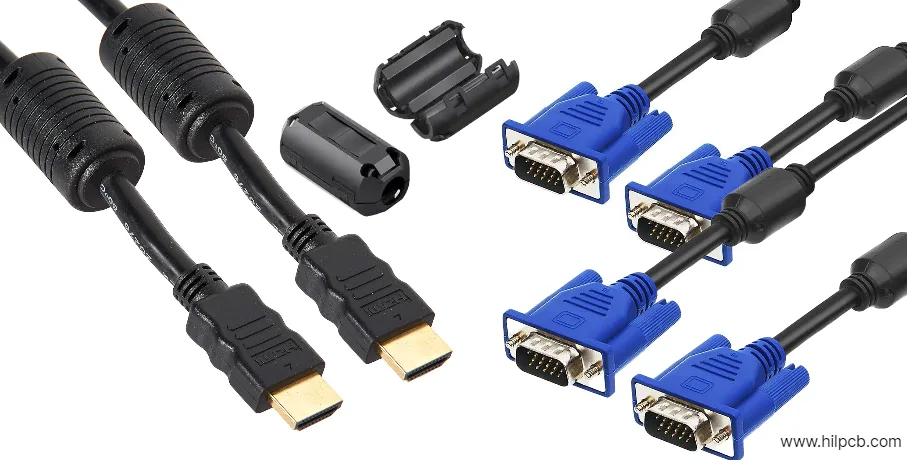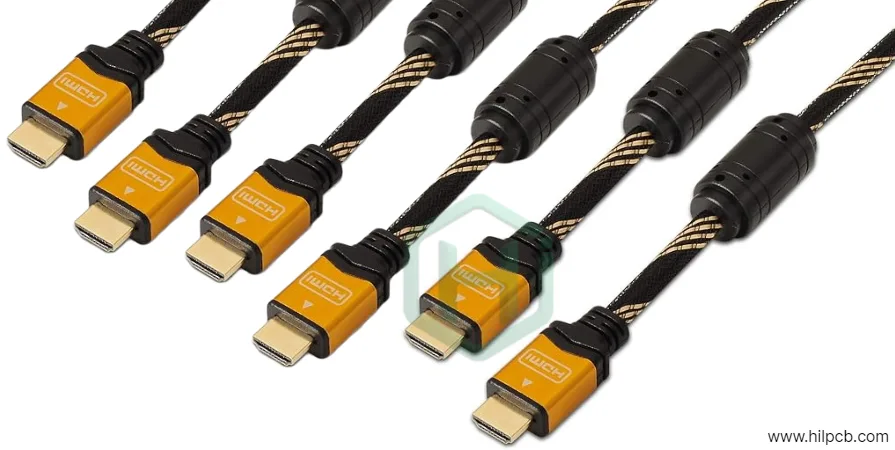A ferrite bead is a passive electronic component primarily used to suppress high-frequency noise and reduce electromagnetic interference (EMI) in electronic circuits. These beads are made from ferrite materials-iron oxide combined with other metal oxides-that have high magnetic permeability. This allows them to absorb and dissipate high-frequency electromagnetic waves, effectively filtering out unwanted noise and improving the overall performance of the system.
Ferrite beads are commonly used in various applications, including PCBs, where they are placed in series with power lines or signal paths to prevent signal degradation due to high-frequency noise. They are essential for maintaining signal integrity, ensuring that the desired signals pass through while unwanted frequencies are suppressed.
The Importance of Ferrite Beads in PCB Design
In PCB manufacturing and assembly, controlling electromagnetic interference (EMI) is critical to ensure that electronic devices operate efficiently without causing or being affected by noise. High-frequency noise can degrade the performance of sensitive components, disrupt data transmission, and lead to potential system failures.
Ferrite beads help reduce EMI by providing an impedance path to unwanted high-frequency signals. As signals pass through a ferrite bead, the component’s magnetic properties absorb and convert the unwanted electromagnetic energy into heat, effectively dampening the noise. This makes ferrite beads particularly useful in designs where signal integrity is paramount, such as in communication devices, medical equipment, consumer electronics, and automotive applications.
Key Roles of Ferrite Beads in PCB Design:
- Noise Filtering: Ferrite beads are excellent at filtering out high-frequency noise from power lines and signal paths, preventing noise from propagating to other parts of the circuit.
- Electromagnetic Interference (EMI) Reduction: By absorbing high-frequency electromagnetic radiation, ferrite beads reduce the risk of interference with nearby electronic circuits and devices, ensuring compliance with electromagnetic compatibility (EMC) standards.
- Improving Signal Integrity: Ferrite beads are crucial for maintaining clean signal paths by filtering out unwanted harmonics and spikes, ensuring that signals remain clear and accurate, which is particularly important for high-speed digital circuits.
- Power Line Filtering: Ferrite beads are often placed on power supply lines to prevent noise from entering sensitive circuits. This is vital in power-sensitive applications where clean power is necessary for stable operation.

How Ferrite Beads Work in PCB Applications
In PCB designs, ferrite beads are typically placed in series with signal lines or power supply lines. The key function of a ferrite bead is to act as a high-pass filter for high-frequency noise. Here's how they work in a typical PCB application:
Placement in Power Lines: Ferrite beads can be installed on the power lines entering the PCB. This configuration helps to absorb high-frequency noise from external sources, ensuring that only clean power is provided to the circuit components.
Placement in Signal Lines: Ferrite beads can also be used on signal lines to prevent high-frequency noise from reaching the components. For instance, in communication circuits, signal integrity is critical, and using ferrite beads can significantly reduce the risk of corrupted data due to external interference.
Reducing Crosstalk: By reducing EMI, ferrite beads also help in reducing crosstalk between adjacent signal traces on the PCB. Crosstalk can lead to signal distortion or data errors, especially in high-speed designs. Ferrite beads ensure that each signal remains isolated from others, reducing potential interference.
How to Choose the Right Ferrite Bead for PCB Applications
Selecting the correct ferrite bead for a given PCB application depends on several factors, including the type of signal, the frequency range, and the specific design requirements. Here are some key considerations when choosing a ferrite bead:
- Impedance & Frequency Range: Ferrite beads are designed to work best within specific frequency ranges. When choosing a bead, consider the frequency of the noise you want to suppress. The impedance of the bead must also match the frequency at which you are working to ensure effective attenuation.
- Current Rating: Ferrite beads have a specified current rating that determines the amount of current they can handle without overheating or degrading. When selecting a ferrite bead, make sure it can handle the current flowing through the circuit without being damaged.
- Application Type: The type of application (e.g., digital circuits, analog circuits, high-speed designs) will also influence the choice of ferrite bead. For high-speed circuits, beads with low resistance at high frequencies are preferred to minimize signal degradation.
- Physical Size & Mounting: Ferrite beads come in a variety of physical sizes, from small surface-mount devices (SMDs) to larger through-hole beads. The size of the bead should be chosen based on the available space on the PCB and the power requirements of the circuit.
- Environmental Considerations: Ferrite beads should be selected based on their environmental resilience, especially if the PCB will be exposed to extreme temperatures, humidity, or other harsh conditions. Make sure the bead’s material and specifications are suitable for the operating environment.

Benefits of Using Ferrite Beads in PCB Manufacturing
Reduced Electromagnetic Interference (EMI): Ferrite beads effectively reduce EMI in high-speed PCBs, ensuring that circuits comply with regulatory standards such as FCC, CE, and UL.
Improved Performance and Reliability: By ensuring clean signal and power lines, ferrite beads help in improving the overall performance and reliability of electronic devices. They minimize the risk of malfunctioning due to noise interference.
Cost-Effective Solution: Ferrite beads are a relatively inexpensive component that provides significant benefits in terms of noise suppression, making them an excellent choice for cost-effective EMI reduction in PCB design.
Minimal Power Loss: Ferrite beads consume minimal power while performing their filtering function, ensuring that the system does not experience significant power loss.
Compatibility with Various Technologies: Ferrite beads are compatible with a wide range of PCB technologies, including analog, digital, and mixed-signal circuits, making them versatile in various applications.
Applications of Ferrite Beads in PCB Design
Ferrite beads are used in a wide range of applications across different industries, including:
- Consumer Electronics: Ferrite beads are used in mobile phones, laptops, tablets, and televisions to reduce EMI and enhance performance.
- Automotive Electronics: In automotive systems, ferrite beads help reduce noise in communication and power lines, improving the reliability of vehicle control systems.
- Medical Devices: Ferrite beads are used in medical instruments to reduce electromagnetic interference and maintain accurate signal readings.
- Telecommunications: Ferrite beads help in signal filtering for telecom systems, ensuring the stability of data transmission.
- Industrial Equipment: In industrial applications, ferrite beads ensure proper signal and power integrity in heavy machinery and automation systems.
Conclusion
Ferrite beads are small yet powerful components that play an essential role in ensuring the performance and reliability of electronic devices by reducing electromagnetic interference (EMI). In PCB manufacturing, their use is critical for maintaining signal integrity and minimizing power line noise. Selecting the right ferrite bead involves understanding the system's frequency range, impedance, and application requirements. By integrating these components effectively, PCBs can operate with greater efficiency and reliability, making ferrite beads a crucial part of modern electronic designs.
For those in need of high-quality PCB manufacturing and assembly services, HILPCB provides expertise in designing and fabricating PCBs that meet stringent performance requirements. Our team ensures that each PCB is carefully designed to integrate components like ferrite beads, ensuring EMI-free performance for your device.
FAQ
Q1: What are ferrite beads used for in PCB designs?
A1: Ferrite beads are used to suppress high-frequency noise and reduce electromagnetic interference (EMI) in PCBs, ensuring better signal integrity and minimizing system disruptions.
Q2: How do ferrite beads work in reducing EMI?
A2: Ferrite beads absorb high-frequency electromagnetic energy from the circuit, converting it into heat and thereby preventing it from interfering with other parts of the system.
Q3: Can ferrite beads be used for both signal and power lines?
A3: Yes, ferrite beads can be placed on both signal and power lines in PCBs to filter out unwanted noise, ensuring clean signal transmission and stable power delivery.
Q4: Are ferrite beads suitable for high-frequency applications?
A4: Yes, ferrite beads are highly effective in high-frequency applications, such as telecommunications, high-speed digital circuits, and medical equipment.
Q5: How do I choose the right ferrite bead for my PCB?
A5: Consider the frequency range, current handling capacity, size, and environmental conditions when selecting a ferrite bead for your PCB design. Match the bead’s specifications with your system's needs for optimal performance.

